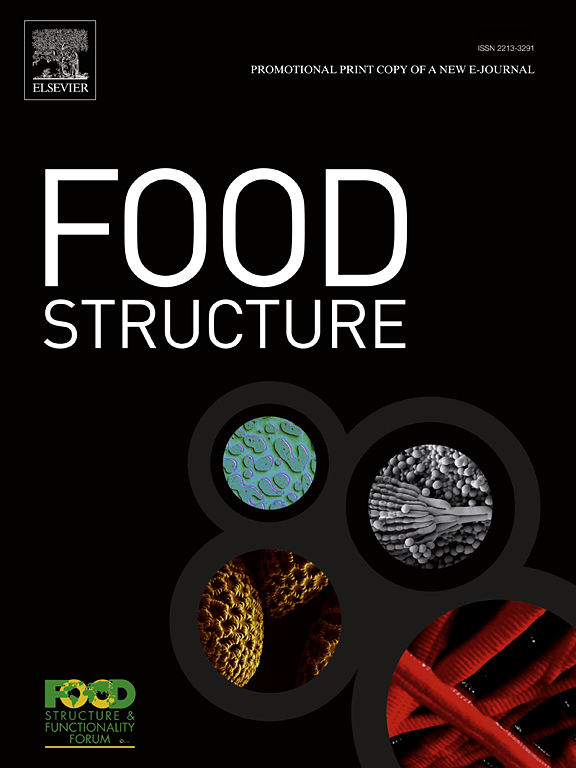气凝胶模板法制备负载β-胡萝卜素的海藻酸盐油凝胶:超临界二氧化碳干燥压力和温度的影响
IF 5.9
3区 农林科学
Q1 FOOD SCIENCE & TECHNOLOGY
引用次数: 0
摘要
油凝胶是一种半固态的凝胶基质,它主要是通过将液体油包裹在油凝胶(如蜡)网络中来构建的。然而,通过利用气凝胶模板的油结构能力,亲水生物聚合物也可以形成油凝胶。这需要形成水凝胶,然后是超临界二氧化碳(scCO2)干燥形成气凝胶,气凝胶可以直接浸入油中形成油凝胶。然而,油的吸收取决于气凝胶的微观结构,这是由scCO2干燥的工艺参数决定的。在这项研究中,研究了压力(100、200 bar)和温度(45、55和65 °C)对气凝胶物理性质的影响。在较高的压力和温度下(200 bar、55℃和65 ℃),较高的体积密度和较低的孔隙度表明存在结构崩塌,这对气凝胶的体积特性有不利影响。气凝胶的比表面积在39.4 ~ 279.1 m2/g之间,其中在200 bar和45 °C时达到最大值。这也反映在最高的膨胀指数(39.9 g/g)、吸油能力(17.8 g/g)和气凝胶的表面形貌上。气凝胶(200 bar|45 °C)比低温凝胶(238.2 μg/g)负载更多的β-胡萝卜素(348.4 μg/g)。这种趋势可归因于气凝胶的更大孔径(~ 11.98 nm)和体积(0.447 cm3 g−1)。由此形成的油凝胶促进了模拟肠液中β-胡萝卜素的体外受控释放。本文章由计算机程序翻译,如有差异,请以英文原文为准。
Fabrication of β-carotene loaded alginate oleogels by the aerogel template method: Impact of pressure and temperature of supercritical carbon dioxide drying
Oleogels are semi solid gel matrices, which are primarily constructed by entrapping liquid oil in a network of oleogelators such as waxes. However, oleogels can also be formed from hydrophilic biopolymers by exploiting the oil structuring ability of aerogel templates. This entails the formation of a hydrogel, followed by supercritical carbon dioxide (scCO2) drying to form aerogels which can be directly immersed in oil to form oleogels. However, the uptake of oil is dependent on the microstructure of the aerogel, which is determined by the process parameters of the scCO2 drying. In this study, the effect of pressure (100, 200 bar) and temperature (45, 55 and 65 °C) was studied on the resultant physical properties of the aerogel. A higher bulk density and a lower porosity at higher pressures and temperature (200 bar|55 and 65 °C) indicated a structural collapse, which had a detrimental effect on the bulk properties of the aerogels. The specific surface area of the aerogels ranged between 39.4 and 279.1 m2/g, wherein the highest value was observed at 200 bar and 45 °C. This was also reflected in the highest swelling index (39.9 g/g), oil absorption capacity (17.8 g/g) and surface morphology of aerogels. The aerogel (200 bar|45 °C) exhibited a greater loading of β-carotene (348.4 μg/g) than the cryogel (238.2 μg/g). This trend can be attributed to the greater pore diameter (∼11.98 nm) and volume (0.447 cm3 g−1) of the aerogel. The oleogels developed thereof facilitated a controlled in-vitro release of β-carotene in the simulated intestinal fluid.
求助全文
通过发布文献求助,成功后即可免费获取论文全文。
去求助
来源期刊

Food Structure-Netherlands
Chemical Engineering-Bioengineering
CiteScore
7.20
自引率
0.00%
发文量
48
期刊介绍:
Food Structure is the premier international forum devoted to the publication of high-quality original research on food structure. The focus of this journal is on food structure in the context of its relationship with molecular composition, processing and macroscopic properties (e.g., shelf stability, sensory properties, etc.). Manuscripts that only report qualitative findings and micrographs and that lack sound hypothesis-driven, quantitative structure-function research are not accepted. Significance of the research findings for the food science community and/or industry must also be highlighted.
 求助内容:
求助内容: 应助结果提醒方式:
应助结果提醒方式:


